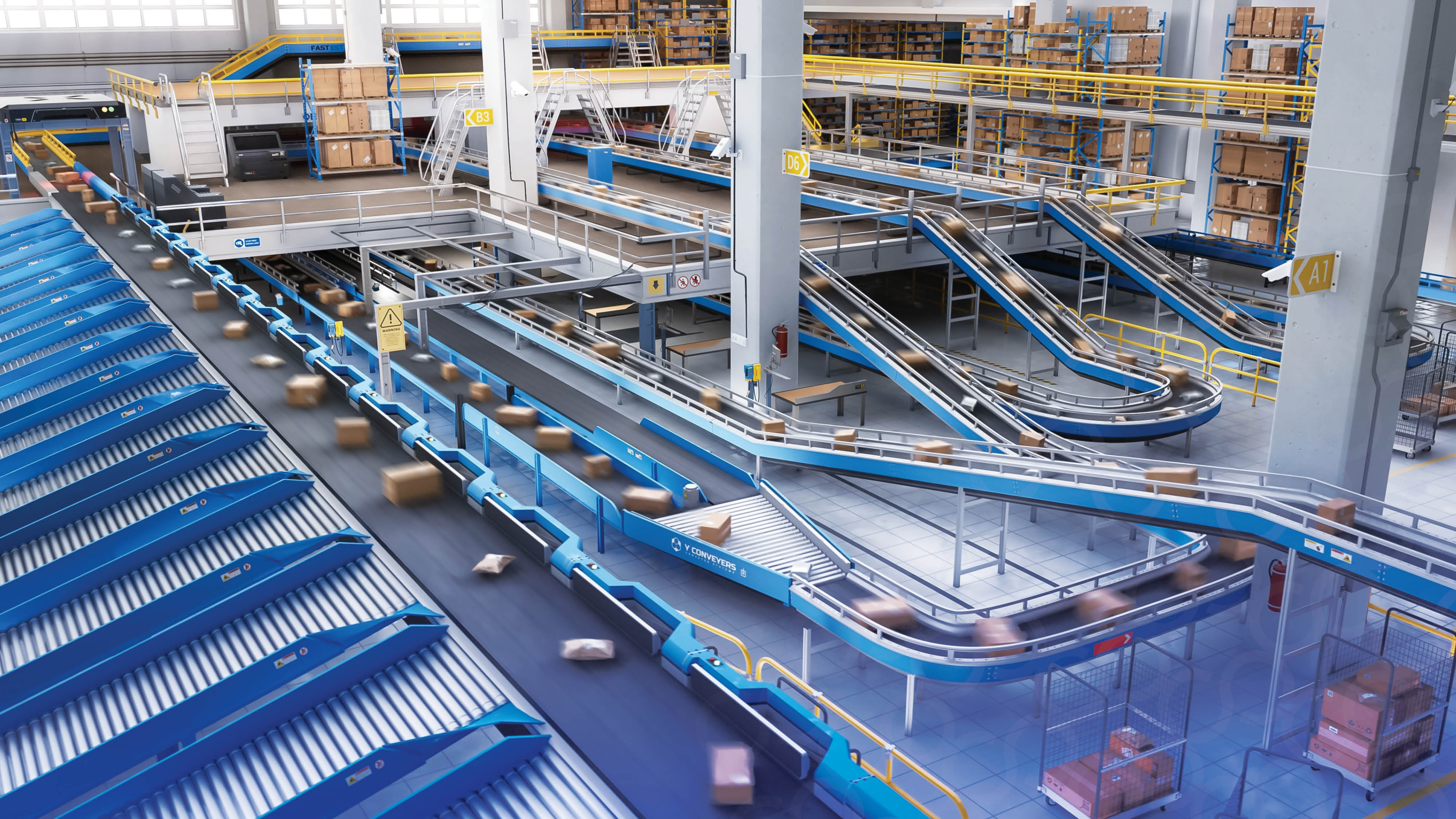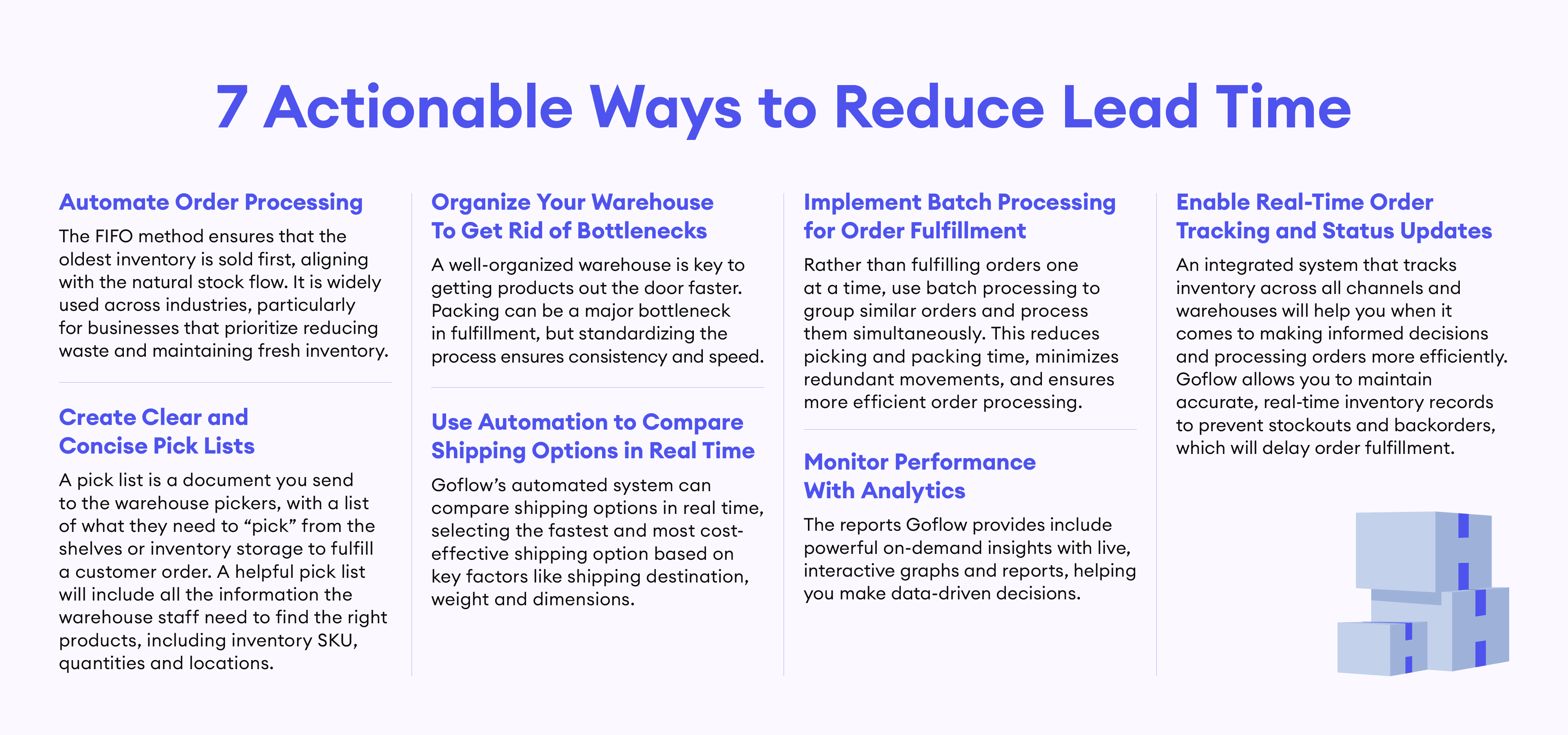Reducing Lead Time: How to Speed Up This Important KPI

Quick lead times are crucial for ecommerce sellers, not just because customers expect to get their purchases quickly, but also because marketplaces have strict lead time requirements.
Whether you’re selling on Amazon, eBay, or Walmart, it’s essential to meet these requirements, as they directly impact your Late Shipment Rate (LSR) and Pre-Fulfillment Cancel Rate (PFCR)—two key metrics that affect your seller account health.
Optimizing your lead time isn’t just about delivering faster. It also helps you earn better reviews, streamline your business, and improve cash flow.
So, how can you keep your lead time as short as possible, no matter how many orders you receive? By the end of this post, you’ll have actionable strategies to reduce your lead times and improve your operations.
What is Lead Time?
Lead time refers to the total time from when a customer places an order to when they receive it.
Formula:
Lead Time (LT) = Order Delivery Date - Order Request Date
This metric includes all stages of the fulfillment process—from order processing to manufacturing to shipping.
Example:
Let’s say you run an ecommerce business selling premium phone cases.
Eleanor orders a sleek black leather phone case from your online store. Since you already have the inventory on hand, the fulfillment process begins immediately.
Your system automatically imports the order and assigns it to the nearest warehouse.
Within a few hours, the warehouse team picks, packs, and prints the shipping label.
The package is handed off to the carrier the same day.
The selected shipping method delivers the package within two business days.
In this case, the lead time is just three days—one for order processing and packing, plus two for shipping.
If Eleanor chooses expedited shipping, the package might arrive the next day, reducing the lead time to two days.
How Does Improving Lead Time Benefit Your Business?
Lead Time is a very important metric that will impact your business in many ways, including:
Marketplace Compliance: Ecommerce platforms have strict requirements for lead times. Complying to these requirements affects your seller account health, which directly or indirectly impacts your sales on those marketplaces.
Improved Customer Satisfaction: Customers want their stuff - fast! According to the State of Shipping Report, 52% of consumers expect delivery in 2-3 days.¹ The quicker your lead time, the more you’ll be able to delight your customers with speedy delivery.
Better Cash Flow: Shorter lead times reduce the time between making a sale and receiving revenue, improving cash flow and financial stability.
Faster Response to Market Trends: With shorter lead times, you can quickly restock in-demand products, helping you stay ahead of competitors.
Increased Operational Efficiency: Reducing lead time minimizes delays, errors and waste, making fulfillment more cost-effective in the long run - especially when you’re selling time-sensitive products with expiry dates.

7 Actionable Ways to Reduce Lead Time
Let’s take a look at some practical strategies to speed up your order fulfillment and improve this essential KPI.
1. Automate Order Processing
Use an order management system that automatically imports your orders from multiple sales channels into a single dashboard. This will help reduce manual entry errors and speed up your initial stages of order fulfillment.
To make this work, you’ll need to implement barcode scanning and RFID tracking technology, so you can track your products electronically. Goflow offers features that auto-import multi-store orders, allowing you to manage all your orders seamlessly from one platform. This means you’ll be able to handle peaks in order volumes seamlessly, without the need for significant resource or complexity increases.
You can set automation rules by store, by listing and even by the customer’s ship-to location. Goflow can also automate shipping label generation. It can select the most cost-effective shipping option, generate labels and update tracking information automatically. The automatic shipping labels can be created individually or in bulk, then Goflow will automatically process the tracking numbers and send shipment confirmations.
2. Organize Your Warehouse To Get Rid of Bottlenecks
A well-organized warehouse is key to getting products out the door faster. Packing can be a major bottleneck in fulfillment, but standardizing the process ensures consistency and speed.
To shorten your lead times, optimize the way you prepare your orders and the layout of your warehouse to allow for faster picking and reduce any bottlenecks.
This means:
Clear Zones: Have designated areas for receiving, storage, picking, packing, and shipping so everything flows smoothly
Smart Organization: Group frequently sold items together and place them in easily accessible locations. Keep popular items closer to shipping and use vertical space wisely
Streamlined Packing: Use packing templates, fast-sealing packaging, and strategic placement of packing materials to increase packing speed
Easy Picking Paths: Design routes that make sense so workers aren't wasting time
Efficient Storage: Use the right storage systems (like pallet racking or shelving) to maximize space
Regular Check-Ups: Keep analyzing your warehouse and make changes as needed
By following these tips and constantly improving your warehouse, you can get products out faster, keep customers happy and stay ahead of the competition.
3. Implement Batch Processing for Order Fulfillment
Rather than fulfilling orders one at a time, use batch processing to group similar orders and process them simultaneously. This reduces picking and packing time, minimizes redundant movements, and ensures more efficient order processing.
For example, Goflow’s batch processing tools can help you group orders by shipping method, product type, or destination, streamlining fulfillment. You’ll be able to effortlessly process thousands of similar orders with just a few clients, guaranteeing faster order fulfillment during peak periods.
If you have items that are usually purchased together, you can even consider bundling them into a single SKU (stock keeping unit) to increase efficiency. This process is referred to as “kitting” and it can speed up the process of picking and packing orders.
4. Enable Real-Time Order Tracking and Status Updates
An integrated system that tracks inventory across all channels and warehouses will help you when it comes to making informed decisions and processing orders more efficiently. Goflow allows you to maintain accurate, real-time inventory records to prevent stockouts and backorders, which will delay order fulfillment.
By automating status updates at key fulfillment stages—such as "order received," "order packed," and "order shipped"—you can reduce miscommunication, eliminate unnecessary delays, and ensure smooth handoffs between teams.
You can even get Smart Order Followups, which will allow you to keep an eye on any potential issues post-shipment. This will help you to maintain healthy seller account KPIs, by giving you proactive alerts that will help you to avoid late shipment marks and related penalties.
5. Create Clear and Concise Pick Lists
A pick list is a document you send to the warehouse pickers, with a list of what they need to “pick” from the shelves or inventory storage to fulfill a customer order. A helpful pick list will include all the information the warehouse staff need to find the right products, including inventory SKU, quantities and locations.
A high-quality pick list will make your warehouse more efficient, as it will guide pickers through the warehouse aisles in a methodical way and help them select the correct products faster. Pick lists will also help you prioritize urgent shipments and reduce human errors in picking.
Goflow can help you with this step too, of course. The software will generate pick lists automatically, based on your designated warehouses and bin locations. The pick list number will be automatically assigned, and you can choose the picker responsible for fulfilling the order.
To learn more about Goflow’s pick list features, you can check out our helpful guide to Creating and Managing Pick Lists.
6. Use Automation to Compare Shipping Options in Real Time
As an established commerce seller, you likely already have shipping options, carriers and methods in place. But how do you know which of those options will be the most efficient choice for any given situation?
The answer: Automation.
Goflow’s automated system can compare shipping options in real time, selecting the fastest and most cost-effective shipping option based on key factors like shipping destination, weight and dimensions. You’ll be able to prioritize and route orders based on product, listing and store, to define fulfillment flows and designate warehouses. This gives you an edge and helps you optimize fulfillment efficiency and maintain strict lead times.
7. Monitor Performance With Analytics
This is where comprehensive reports and analytics really come in handy. The reports Goflow provides include powerful on-demand insights with live, interactive graphs and reports, helping you make data-driven decisions.
In addition to monitoring your Lead Time, you’ll be able to see insights into many important KPIs, including:
Processing times
Shipping durations
Shipping costs
Profit and Loss
Sale totals by channel
Performance by store
Return rates
Overall efficiency
Regularly analyze key performance indicators related to order fulfillment, so you can identify any bottlenecks and areas for improvement.
After all, maintaining a quick lead time isn’t just something you fix once and forget about - it’s an important metric you’ll need to continuously optimize for the health of your business.

Ready to Take Control of Your Lead Time?
Reducing lead time is about more than just faster order processing—it’s a game changer for your ecommerce business. Without an awareness of the important factors impacting your lead times, you might not meet important industry standards and this can have knock-on effects on your ability to run your business.
By implementing these strategies and lead time best practices, you’ll:
Stay compliant with marketplace lead time requirements
Improve customer satisfaction with faster delivery
Streamline operations and reduce bottlenecks
Increase cash flow by speeding up revenue cycles
Take the first step today by analyzing your current fulfillment processes, identifying areas for improvement and exploring how Goflow’s features can assist in improving ecommerce KPIs and achieving your lead time reduction goals.
Start today by scheduling a demo!
¹ State of Shipping Report 2023: https://lp.goshippo.com/rs/241-IMB-691/images/RPT_2023_State_of_Shipping_v2.pdf
